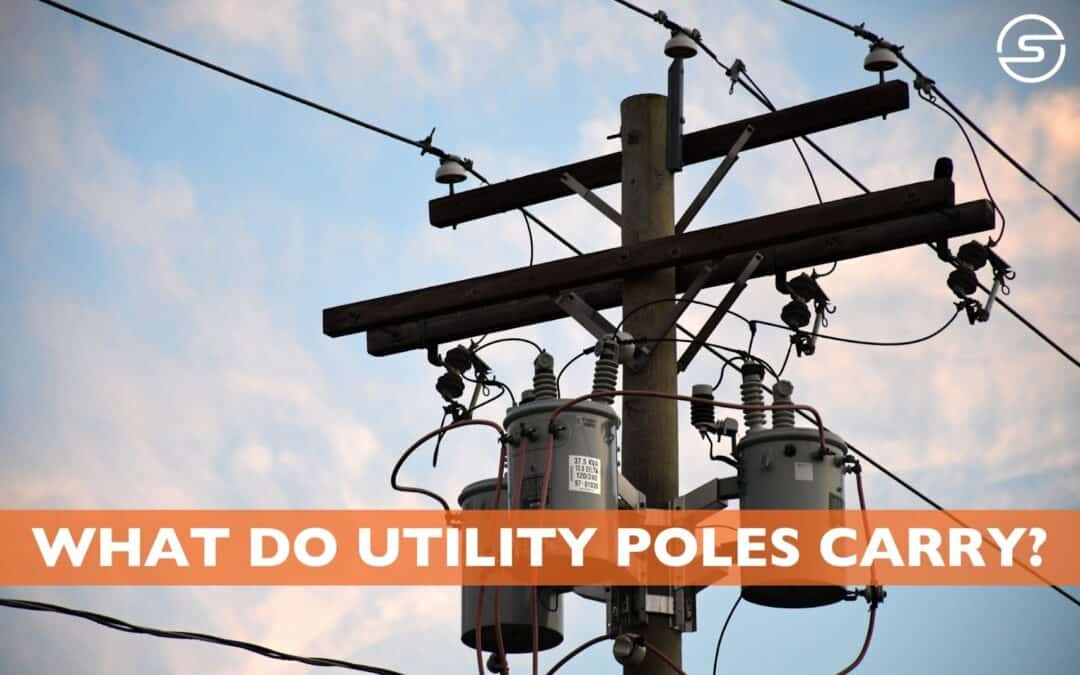What Do Utility Poles Carry?
Utility poles, also called telephone poles or power poles, are an essential part of urban and rural infrastructure. Though we grow up around them and frequently see people working on them, many of us don’t think too hard about utility poles until the one we count on for making our lives comfortable comes down in a storm. Suddenly, we find ourselves without the services we have come to rely upon. Then we realize quickly how important they are.
Utility poles were first used in the mid-1800s to carry telegraph wires. Since then, their uses have expanded. Today, utility poles bring electricity, telephone, cable TV, and internet services to homes and businesses. We also use them to mount streetlights. While great technological strides enable us to transmit telephone, data, and video without wires and cables, they remain necessary for bringing electricity to homes and businesses across the nation.
Utility poles are efficient: they are easy to put up and relatively inexpensive to expand our power networks compared to digging up trenches for a conduit to carry wires and cables. Poles can be used on all sorts of terrain, in rural as well as urban settings. To understand the importance of these poles for modern life, it is helpful to know what components they contain and how these components work together.
Power Equipment for Electricity Transmission
Power poles elevate and carry high voltage lines across vast networks to transmit electricity to wherever it is needed. Power lines are mounted on the cross-arms of the pole at the uppermost section for safety reasons. In addition, the poles typically carry two types of power equipment: transformers and switches. Transformers are barrel-shaped devices that reduce the voltage from high voltage to lower voltage so that the electricity can be used in homes and businesses. These lower voltage lines, called service drops, run from the poles into individual buildings. These lower voltage lines were overhead a few decades ago, but today, they are often buried.
Switches control the flow of electricity by connecting or disconnecting circuits as needed. Both transformers and switches are necessary for delivering electricity safely and efficiently to customers. Poles will also have fuse cutouts and lightning arrestors, which can prevent outages or damage when a current surge or overload occurs. The poles also have insulators that keep the wires from touching each other or the pole, as well as a ground wire and a neutral wire.
Although the bases of utility poles are buried about six feet, you will also see guy wires attaching the poles to the ground to keep them stable.
Telephone, Internet, and Cable TV
The additional cables are mounted below the equipment used for transmitting electricity, with a neutral space dividing the two areas. Although many people in urban areas today do not have landline telephones in their homes, telephone cables can also be found on utility poles, providing voice communication services to customers, including businesses, who still rely upon landline telephones. These cables are insulated copper wires that carry electrical signals between phones and other devices. The cables are connected to terminals at either end, which allows them to be connected or disconnected as needed.
Utility poles can also be used to carry lines for internet access. High-speed fiber optic cables are often installed on utility poles, allowing customers to connect to the internet faster than traditional copper wire connections. Additionally, wireless antennas can be mounted on utility poles to provide broadband access over large areas. Cable TV lines can also be carried on utility poles, although many people now use satellite services for television.
Are Utility Poles Here to Stay?
Utility poles make it easy and relatively inexpensive to provide electricity, telephone, internet, and cable TV services to new areas. Today, telephone, internet, and cable TV services have been able to use new technologies that do not need to rely on poles for transmission, even though some people still need or use them. However, unless technology advances to the point that everyone can get “off the grid” by being able to produce their own electrical power,
electricity will always need transmission lines.
At the same time, the vulnerability of poles to problems – storm damage, vehicle accidents, and so on – and perceptions that power poles are unsightly and present unique dangers have shifted some communities to using underground conduits for power transmission. But burying lines has its challenges and limitations, including the difficulty and cost of repairing outages and updating equipment.
Protecting the Workers Who Keep Our Services Flowing
For now and in some time to come, utility poles will be around and will need to be maintained because we need the utilities that these poles bring to our communities. Everything from electrical power to street lighting depends upon the nearly 180 million utility poles crisscrossing the nation. So the next time you pass one of those poles, take a moment to appreciate how important this humble piece of landscaping is to your life.
With hundreds of millions of people relying on utility poles and the services they bring, you need thousands of people to keep them working. At Safeguard Equipment®, we know these workers are vital to our nation’s life, and it has been our mission to do what we can to keep these workers safe from the dangers of working on these utility poles. We design and manufacture voltage and current detectors that alert them to the presence of energized lines and equipment, particularly when storms or other events have knocked down those lines. Our products can prevent workers from suffering shock, electrocution, and other harm. Our latest product, the COMPASS ProTM, does even more: it can detect injury events such as falls and arc flashes. Through the Safeguard app, our product will alert safety personnel of the need for emergency medical response and get personnel on-site without delay. To find out more about our products, contact Safeguard Equipment today.
Views: 15

